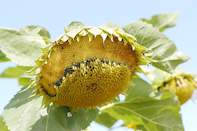For farmers in dryland production regions in South Africa, sunflowers as a summer crop can be an appealing option. Not only can sunflowers produce relatively consistent yields in difficult weather conditions, but it is also relatively drought tolerant and has lower input costs compared to other summer rainfall crops such as maize.

A report by the Bureau for Food and Agricultural Policy (BFAP) says sunflowers can also produce a crop on marginal soils and with very little or no additional fertiliser. The report further states that although there is a perception that sunflowers are not as profitable as maize, several crop budgets from, example Grain SA, shows that good sunflower crop yields may actually result in the opposite - sunflower being more profitable than maize.
A disadvantage of sunflowers is, however, that less crop residue is left on the land after harvesting. Crop residues of maize provide a useful source of roughage for livestock.
Conservation Farming and Sunflowers
The principles of conservation agriculture include reduced tillage or no-tillage, retaining crop residues to produce a layer of mulch as well as crop rotation. There has been a positive trend during the past few years of more sunflower hectares being planted using no-tillage farming practices in the Great Plains region of the US and Canada, but South Africa still lags in the conversion to conservation agriculture, especially in terms of sunflower production, most probably due to the lack of local guidelines and experience.
Studies at the Grain Crops Institute (GCI) by the Agricultural Research Council (ARC) in Potchefstroom showed that the effect of tillage systems and nitrogen fertilisation on the seed oil content is unpredictable. Yet, several studies have shown that conservation agriculture slows down water runoff and soil erosion, improves water infiltration into the soil and restores soil quality.
Pests and Diseases of Sunflowers

Pests and diseases should be controlled according to an integrated pest management practice (IPM) and only sprays registered for the use on sunflowers should be used.
The main diseases in sunflowers are caused by fungi. Fungal diseases include rust, downy mildew, Verticillium wilt, Sclerotinia stalk and head rot (especially in early planted regions), Phoma black stem and leaf spot.
Sclerotinia sclerotiorum is a significant threat to the production of crops such as sunflowers and soya beans in South Africa. The primary sign of Sclerotinia is white, cotton-like masses on the flowerhead.
Current control of Sclerotinia includes agricultural practices and the use of registered fungicides for sunflowers. Crop rotation and lowering plant density aim to reduce the number of sclerotia in the soil and to create conditions that are unfavourable for the disease. Correctly timing applications of fungicides is essential in limiting the disease.
Due to the potentially harmful effect of fungicides on the environment and beneficial insects like bees, biological control of Sclerotinia is researched.
There is much evidence which suggests that biological control agents (BCAs) have great potential to control Sclerotinia diseases. Other sunflower diseases are Alternaria leaf spot, bacterial head rot and brown rust.
Insect pests on sunflowers include American bollworm, Astylus beetle, black maize beetle, nematodes and weevils.
By Marinda Louw